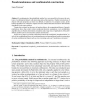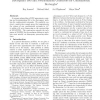406 search results - page 1 / 82 » Pseudorandomness and Combinatorial Constructions |
CORR
2006
Springer
13 years 8 months ago
2006
Springer
Abstract. In combinatorics, the probabilistic method is a very powerful tool to prove the existence of combinatorial objects with interesting and useful properties. Explicit constr...
ECCC
2010
13 years 8 months ago
2010
We define a combinatorial checkerboard to be a function f : {1, . . . , m}d {1, -1} of the form f(u1, . . . , ud) = d i=1 fi(ui) for some functions fi : {1, . . . , m} {1, -1}. T...
FOCS
1996
IEEE
14 years 21 days ago
1996
IEEE
A common subproblem of DNF approximate counting and derandomizing RL is the discrepancy problem for combinatorial rectangles. We explicitly construct a poly(n)-size sample space t...
IJNSEC
2010
13 years 3 months ago
2010
Pseudo-random subsets of the set {1, 2, . . . , N} have many applications in the fields of network security, cryptography and other security issues. Recently, Dartyge and S
APPROX
2004
Springer
14 years 1 months ago
2004
Springer
A quantum encryption scheme (also called private quantum channel, or state randomization protocol) is a one-time pad for quantum messages. If two parties share a classical random s...


